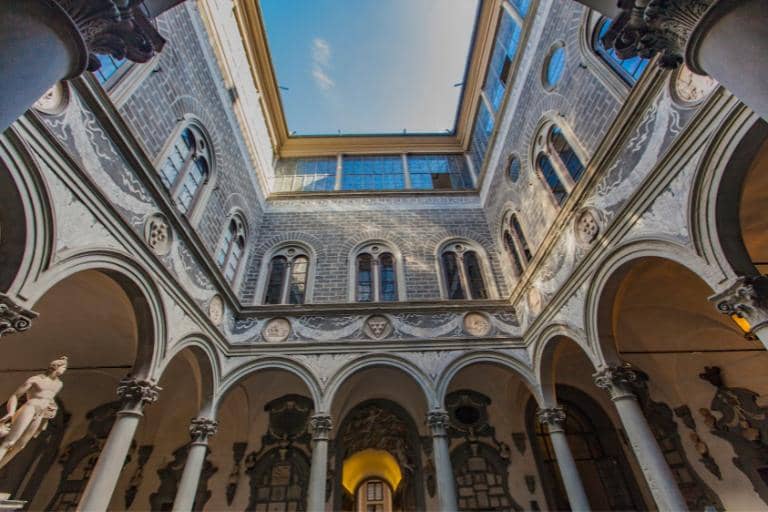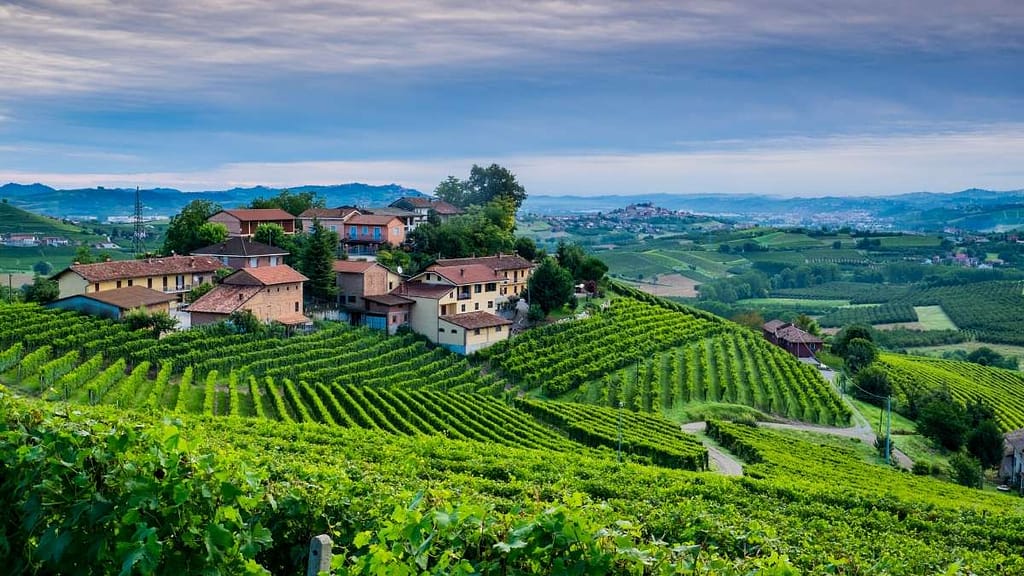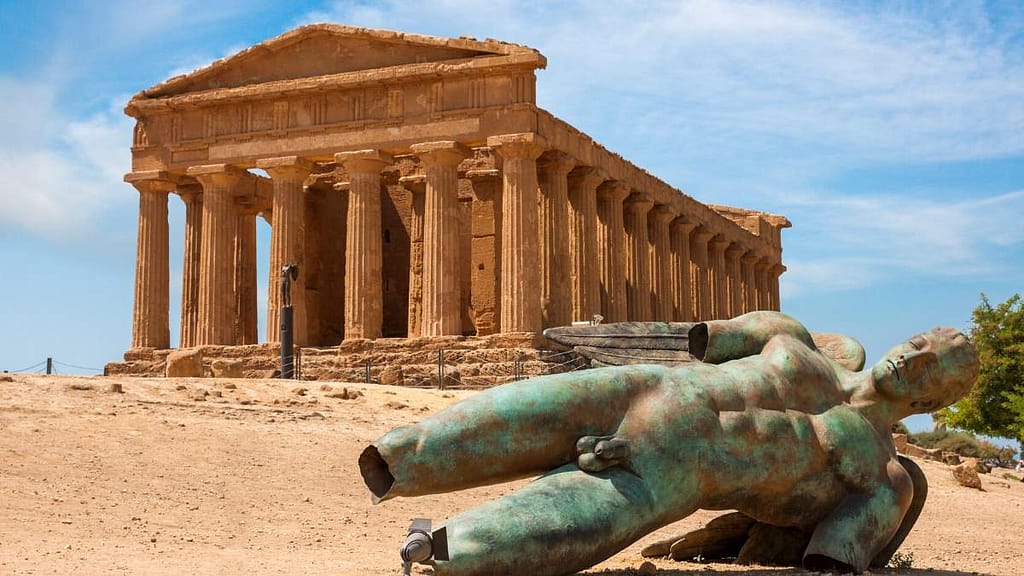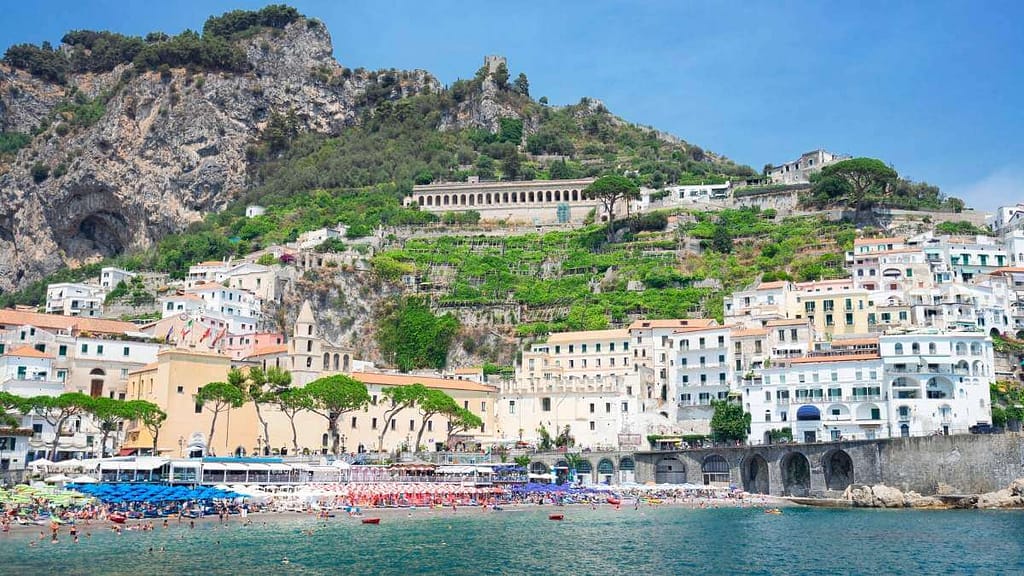Today, we’re talking about Florence. It’s one place that stole my heart from the moment I arrived. While I love Rome, Florence is a different Italian experience. For me, Rome is the heart and spirit of the Roman Empire, while Florence is the birthplace of the Renaissance and the home to the powerful Medici family. It’s a place that draws you in with art, culture and history.
I once wrote that: “Florence is like a matronly grand-aunt who can tell you stories of the past and show you the treasures she has stored in her attic. She is majestic, well-connected to power and incredibly wealthy.” I feel like this description still holds true for me.
Today, Florence is one of the most popular destinations in Italy, and it’s easy to see why. It has all the attractions that appeal to tourists, including museums, churches, stunning architecture, history and food. Before I came here, I knew I would like it, but I never anticipated loving it.
- My love affair with Florence and the Renaissance
- A brief history of Florence
- Who were the Medici, and how did they get so rich?
- Florence and Italian identity
- Visiting Florence, a must-visit destination for travellers
- Foodie Florence: Culinary delights and specialty dishes
- How to get to and around Florence
- How to get around Florence
- When to visit
My love affair with Florence and the Renaissance
One thing you might or might not know about me is that I have a degree in history. When I was in school, I was fortunate to have a Renaissance expert as my teacher. His name was Professor Bartlett, and the man wasn’t just smart. He knew how to tell a story and make it come alive. His classes were some of my favourites and really inspired me to visit Italy.
He was the kind of person who was made for his job. Whenever people tell me that history is boring, I always say that you think it’s boring because you never had a good history teacher. I was fortunate to have a few, including Professor Bartlett, who, in many ways, fuelled my curiosity and inspired my love for Italy. If it wasn’t for them, I might not be here today telling you about Florence or even Italy. But here we are.
A brief history of Florence
Let’s dive a bit into the history of Florence, as I think it’s an interesting one. I promise not to turn this into a history lesson, just some points to give you a better understanding of what makes Florence so special. Like many other places in Italy, Florence was Founded by the Romans in 59 BC. Thanks to its location on the Arno River, Florence flourished as a trade center. The fall of the Western Roman Empire eventually led to Florence evolving into a powerful city-state during the Middle Ages.
Before we get to the good part, it’s important to mention that somewhere in there, we had the Black Death. The Black Death was a devastating bubonic plague that swept across Europe in the mid-14th century. It’s estimated that it killed 30-50% of Europe’s population. That’s a lot of people.

There was a major social change, and the plague’s devastation led to a sense of renewal and a desire to live life to the fullest. I think many of us can relate to this concept. This chance also fostered a more open-minded and artistic spirit.
We also saw shifting power dynamics as the death of a significant portion of the population created a shortage of labour. This gave rise to higher wages for workers and potentially led to a more prosperous middle class with leisure time for cultural pursuits. So, in a nutshell, the Black Death undeniably played a role in the historical context that led to the Renaissance, but it wasn’t the sole cause of what became the Renaissance movement which came a few decades later.
The most interesting part is the rise of Florence and the Renaissance between the 14th and 16th centuries. Florence is widely known as the birthplace of the Renaissance, a cultural and intellectual movement that emphasized classical learning, humanism, and artistic expression.

The seeds of the Renaissance were already sown before the Medici rose to power. However, their influence was undeniable. These guys had money—like Scrooge McDuck, kind of rich. Their vast wealth allowed them to become patrons of the arts on a grand scale. They supported the works of great artists like Michelangelo, Leonardo da Vinci, and Botticelli, fostering a flourishing artistic environment in Florence. This artistic explosion became a hallmark of the Renaissance.
Who were the Medici, and how did they get so rich?
The Medici family’s rise to power wasn’t a sudden event. It was more like a gradual climb fueled by their success in banking and a keen understanding of political influence. Their story started in the 13th century when the family transitioned from rural origins to becoming successful wool merchants in Florence.
By the 14th century, Giovanni di Bicci de’ Medici recognized the potential of banking. He established the Medici Bank, which grew to become the largest bank in Europe. Talk about a success story. Their innovations in financial services like currency exchange and loans secured their position as a powerful banking family.

The Medici family understood the power of influence, which is what makes them so fascinating. They strategically used their wealth to gain political favour. Cosimo de Medici, often referred to as Cosimo the Elder solidified their hold through political maneuvering and financial backing. He became the unofficial leader of Florence despite not holding any official office. This ushered in a period of Medici dominance in Florentine politics.
The influence of the Medici family on Europe
The Medici family knew how to play the power game. They strategically married their daughters into influential European families, forging alliances with powerful houses in France, England, and the Papacy.
They were known as patrons of the arts and sciences. Their generous support for artists like Michelangelo and Leonardo da Vinci, as well as scholars and philosophers, made Florence the epicentre of the Renaissance. The Medici Bank’s reach and influence earned them the title “Bankers of Europe.” They established branches across major European cities like London, Rome, and Lyon. This vast network allowed them to control a significant portion of European finance.
The Medici Bank provided loans to kings, queens, and even the Papacy. This financial leverage gave the family an immense influence over European politics and ensured their continued prominence. Eventually, the Medici Bank’s power declined in the late 16th century. But that didn’t stop their legacy as a powerful family who influenced banking, politics, and cultural development, guaranteeing their mark on European history.
Florence and Italian identity
Florence played a pivotal role in the development of the Italian language. The Tuscan dialect used in Florence became the foundation for modern Italian. Although Italy wasn’t yet a unified nation at the time, Florence’s cultural achievements contributed to a sense of shared identity among Italians. In 1865, Florence briefly served as the capital of a unified Italy.

What makes Florence so significant?
Florence’s role in the rise of the Renaissance was groundbreaking. It revolutionized art, architecture, literature, and philosophy, leaving a lasting impact on European culture. In short, Florence was a key player in the European Renaissance. It influenced art, thought, and language. Its cultural legacy continues to shape Italy’s identity and the world’s appreciation for art and history.
So, now I hope you see how important Florence was and can get a better appreciation for it when you visit. It’s a gorgeous city built with all that Medici money and if you love art and architecture, Florence really is the place to be. Even if you don’t care that much about the past, I think you’ll love it for the beautiful city it is.
Visiting Florence, a must-visit destination for travellers
If you decide to do Florence as a day trip from Rome, Venice or whatever, you’re doing yourself a disservice. I would recommend a minimum of 2 full days in Florence and about 5 to fully immerse yourself in the essence of the city.
Whenever I go to Florence, I love staying there. It’s a place that hits you differently at different times of the day. The last time we were in Florence, it started to rain, and it was magical. You can’t experience that in a few hours or if you’re running between museums and churches.
Must-see sights for first-timers in Florence

Duomo (Cathedral of Santa Maria del Fiore)
The Duomo is Florence’s most iconic symbol. Its construction started in 1296 and lasted almost two centuries. The famous dome, designed by Filippo Brunelleschi, was a feat of engineering at the time and was inspired by the Pantheon in Rome. Brunelleschi’s dome, completed in 1436, was a revolutionary feat of engineering for its time. Its innovative design, built without temporary support, continues to impress architects today.
The Duomo is the largest church in Florence and a symbol of the city’s wealth and power during the Renaissance. You can climb the dome for some breathtaking panoramic views of Florence. The Baptistery, with its famous bronze doors by Lorenzo Ghiberti, depicts scenes from the New Testament.

Ponte Vecchio
This bridge, over the Arno River, is the only bridge in Florence that wasn’t destroyed during World War II. It’s lined with centuries-old goldsmith shops, a tradition that began in the 16th century. Even if you’re not buying, browsing the exquisite jewelry displayed in the shops is a delightful experience. The bridge itself offers picturesque views of the Arno River.
Palazzo Vecchio & Palazzo Pitti
We couldn’t talk about Florence without a stop at the Medici homes. Palazzo Vecchio and Palazzo Pitti were the grand residences of the powerful Medici family. Palazzo Vecchio is an imposing fortress-like palace that was the seat of the Florentine government for centuries. Here you’ll find stunning frescoes and sculptures, including works by Donatello and Michelangelo. The opulent Palazzo Pitti served as the Medici family’s private residence. Visit its grand apartments, explore the Boboli Gardens (once the Medici’s private gardens), and admire the vast collection of Renaissance paintings.

The Boboli Gardens are one of my favourite spots in Florence. I recommend not skipping them. You can escape the crowds and immerse yourself in the Medici family’s private green haven. These sprawling gardens are adorned with sculptures, fountains, and manicured hedges and offer a tranquil setting and stunning city views.
Accademia Gallery
Here is where you’ll find Michelangelo’s David. This iconic masterpiece of Renaissance sculpture is the star attraction here. The gallery also houses other important Renaissance works, including sculptures by Donatello and paintings by Botticelli. It’s a great place to spend a few hours and enjoy all the art around you.
PRO TIP: Get a combo skip the line ticket for both the Accademia and the Uffizi Gallery entrance. Get yours today.
Uffizi Gallery
This was one of my favourite museums. Think Renaissance Masterpieces Galore. Here, you’ll find an extensive collection of Renaissance art, including masterpieces by Botticelli (including The Birth of Venus and Primavera), Michelangelo, da Vinci, Titian, and many more. The Uffizi offers a comprehensive overview of the artistic development during the Renaissance.
Piazza della Signoria
For centuries, Piazza della Signoria has been the center of Florentine politics. Palazzo Vecchio, the town hall, dominates one side, while statues and monuments tell stories of the city’s past. This bustling square is an open-air museum where you can find sculptures like a copy of Michelangelo’s David, Cellini’s Perseus with the Head of Medusa and the equestrian statue of Cosimo I de’ Medici, founder of the Grand Duchy of Tuscany.

Palazzo Vecchio
Palazzo Vecchio is a testament to Florentine power and artistry. This imposing structure began as a 13th-century fortress before transforming into the opulent seat of the Medici family. Marvel at its rusticated stone exterior, the soaring clock tower, and the grandeur of the courtyard.
Explore the lavish Salone dei Cinquecento (Hall of Five Hundred) and the Medici’s private apartments, brimming with art and history. Climb the Vasari Corridor for a unique peek into the city, or ascend the Arnolfo Tower for breathtaking panoramic views. Palazzo Vecchio is a must-visit for anyone seeking to understand the heart and soul of Florence.
Santa Croce Church
While the Duomo is the star of the show, Santa Croce shouldn’t be missed. Nicknamed “the Pantheon of Florence,” it’s the final resting place of many Renaissance greats like Michelangelo, Galileo Galilei, and Machiavelli. The church itself is a beautiful example of Gothic architecture with remarkable frescoes.
Oltrarno District
Cross the Arno River and discover a different side of Florence. The Oltrarno district boasts a laid-back atmosphere and a thriving artisan scene. Wander through charming streets and peek into workshops where skilled craftsmen create everything from leather goods and jewelry to traditional Florentine paper.
Foodie Florence: Culinary delights and specialty dishes
Florence is a feast for not just the eyes but also the stomach. As many of them are meat dishes, I can honestly tell you that I have not tried them, and I actually had to look up what they were. But if you’re a meat eater, here are your options:
1. Bistecca Fiorentina: This iconic dish is a must-try for meat lovers. It features a thick-cut (around 5cm) T-bone steak, traditionally grilled over charcoal or wood. The emphasis is on the quality of the meat, cooked to a perfect medium-rare to retain its juicy tenderness.
2. Lampredotto: For the adventurous eater, Lampredotto is a unique Florentine street food. Made from the fourth stomach of a cow, it’s slow-cooked with vegetables in a tomato broth until tender. Served in a bread roll with a spicy or green sauce, it’s a hearty and flavorful option.
3. Ribollita: This rustic stew is a quintessential Tuscan comfort food, perfect for colder months. Packed with vegetables like cannellini beans, black cabbage (cavolo nero), and leftover bread, it’s simmered in a rich tomato broth. Hearty and satisfying, it embodies Florentine home-cooking traditions.
4. Gelato: Florence has many great gelaterias where you can get your gelato on. It’s one of my favourite things to eat no matter where I am in Italy. Don’t be afraid to experiment with unique flavours like pistachio, ricotta fig, or even rose. Want a more immersive experience? Take a gelato-making class!
Bonus Tip: Elevate your wine experience with local Tuscan wine tour. The region is known for its Chianti Classico, a red wine with a fruity and earthy character. You can also explore other regional varieties like Vernaccia di San Gimignano, a white wine known for its crisp acidity.
Mercato Centrale: Ditch fancy restaurants and delve into the heart of Florentine life at the Mercato Centrale. This bustling indoor market offers a feast for the senses. Explore stalls overflowing with fresh produce, local cheese, cured meats, and Tuscan specialties. Sample delicious street food or grab ingredients for a picnic lunch.
Cooking Classes and tours: Learning to cook is a fantastic way to immerse yourself in the local culture. Take a cooking class and unlock the secrets of Tuscan cuisine. Learn to make classic dishes like hand-rolled pasta, flavorful sauces, and decadent desserts. Enjoy your creations with your fellow classmates, paired with local wines for a truly authentic culinary experience.
Recommended food tours and cooking classes:
How to get to and around Florence
While Florence has its own international airport, Amerigo Vespucci Airport, it’s relatively small and may not have as many flight options, especially from North America, as some other airports in Italy.
By Plane: Another option is to fly into Pisa International Airport (PSA), a larger airport located about 50 km west of Florence. There are more flight options into Pisa, especially from North America, and from there, you can take a train or bus to Florence.
By Train: Florence is a major railway hub in Italy, with connections to other major Italian cities like Rome, Milan, and Venice. High-speed trains can whisk you to Florence in a comfortable and efficient manner.
By Car: Florence is located on the A1 motorway, the main motorway connecting Milan and Naples. While driving is an option, keep in mind that the historic center of Florence is largely pedestrianized, so parking your car in the city center might be challenging.
How to get around Florence
The historic center of Florence is relatively compact and pedestrian-friendly. This makes it fantastic for exploring the main attractions, charming streets, and hidden piazzas at your own pace. Comfortable shoes are recommended, as you’ll likely be doing a fair amount of walking.
Buses and trams: Florence has a good public transportation system that’s easy to use. Buses connect various parts of the city, including the historic center and the outskirts. Tickets can be purchased at newsstands or tobacco shops. The modern tram system is a convenient option for longer distances, particularly useful for travelling between the city center and the airport. Tickets can be purchased on board or at vending machines at tram stops.
PRO TIP: Get the Firenze Card, a tourist pass that offers free entry to many museums and attractions, to explore the best Florence has to offer.
Taxis: Taxis can be a good option for late-night travel or if you have luggage. You can hail one on the street at designated taxi ranks or call a radio taxi service. Be aware that taxis can be expensive, especially during peak hours.
Biking: Florence offers a bike-sharing program, making it a great option for exploring the city at a leisurely pace. You can rent bikes from various locations around the city.
Walking tours: Joining a walking tour is a fantastic way to combine sightseeing with learning about Florence’s history and culture. Many tours are offered in different languages, and some even focus on specific themes like Renaissance art or Florentine cuisine.
Recommended walking tours in Florence:
When to visit
As I’ve said before, you can visit Italy all year round. My recommendation is January to March or November. If you can’t travel to Italy during that time, here is what to consider. For pleasant weather and manageable crowds, shoulder seasons (April/May or September/October) are ideal.
If you prioritize long days, a vibrant atmosphere, and don’t mind the crowds, peak summer (July/August) might be suitable, but be prepared for higher costs. Ultimately, the best time to visit Florence depends on your personal preferences and priorities. Consider the pros and cons of each season to make an informed decision.
PRO TIP: Stay in the heart of Florence to get the best of your experience. This way, you’re close to all the major attractions and don’t have to travel far to get back to your hotel. Research hotels and private stays with Booking.com
Consider visiting Florence during the week if possible. Weekends tend to be busier, especially during peak season. Florence is also one of those destinations where “hit and run” tourism is quite common. This means visitors who come here do so for a few hours and leave without contributing much to the local economy.
If you’re on a tight budget, shoulder seasons offer the best value for flights and accommodation. Research specific events or festivals happening during your desired travel dates to make the most of your trip.
This post may contain compensated links. Find out more info in our DISCLAIMER.



